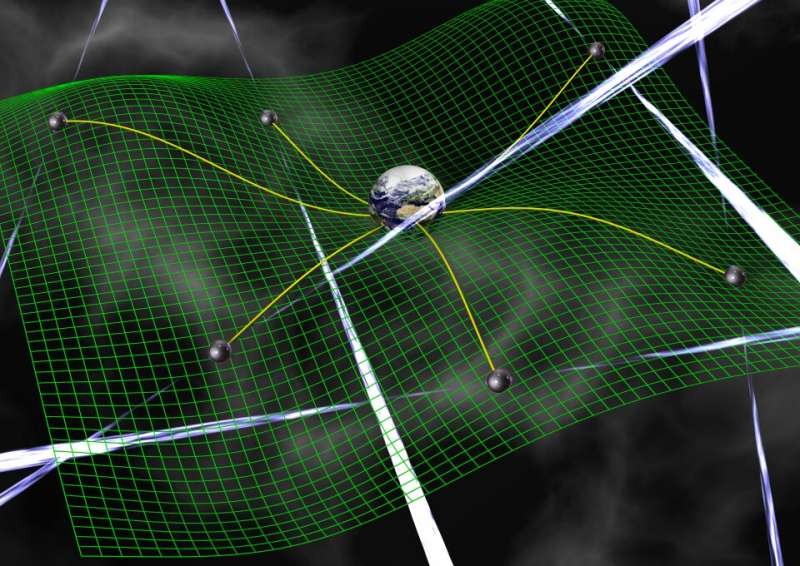This article has been reviewed according to Science X's editorial process and policies. Editors have highlighted the following attributes while ensuring the content's credibility:
fact-checked
peer-reviewed publication
trusted source
proofread
Clock-like precision of pulsars opens new window for studying gravitational waves

A team of European astronomers, along with Indian and Japanese colleagues, has reported evidence that strongly suggests the detection of ultra-low-frequency gravitational waves. Such waves, which have not previously been observed, probably originate from pairs of supermassive black holes at the center of merging galaxies.
This discovery is the result of more than 25 years of observations with the most sensitive radio telescopes in Europe and India, including the Westerbork Synthesis Radio Telescope (WSRT) in the Netherlands. In doing so, they have opened a new window for studying gravitational waves, which can give astronomers a glimpse into the universe's best-kept secrets. The team's research has been published in a series of articles in the journal Astronomy & Astrophysics.
The scientists on the team collaborate within the European Pulsar Timing Array (EPTA) and the Indian Pulsar Timing Array (InPTA). In EPTA, astronomers and theoretical physicists from more than ten institutions across Europe are using observations of very regular pulses from pulsars—highly magnetized rotating neutron stars—as a gravitational wave detector that is essentially the size of our Milky Way galaxy. From the Netherlands, astronomers from ASTRON and Radboud University are involved. It was also announced today that other teams from around the world have independently reported the same observations.
Cosmological clocks
The astronomically vast gravitational wave detector, which spans 25 specifically chosen pulsars scattered across the Milky Way, enables researchers to investigate gravitational waves at ultra-low frequencies with wavelengths of several light years. Such frequencies are impossible to observe with detectors such as LIGO and Virgo, which are limited to wavelengths of several kilometers. These ultra-low (nanohertz) frequencies provide the opportunity to observe unique sources and phenomena.
Emma van der Wateren, Ph.D. student at the Netherlands Institute for Radio Astronomy ASTRON and Radboud University, explains, "Pulsars are fantastically accurate cosmological clocks. We use the changes in the extreme regularity of the 'ticking' of the clocks to detect the subtle stretching and compression of spacetime caused by gravitational waves." The gravitational waves reported in the current study are probably a sum of signals from a very large number of supermassive black holes orbiting each other very slowly.
The researchers believe that the results provide a new window for exploring the universe. Astronomer Gemma Janssen (ASTRON, RU) says, "These ultra-low-frequency gravitational waves contain information about the universe's best-kept secrets. We still know little about the population of double black holes with huge masses—from millions to billions of times the mass of the sun—which form when galaxies merge."
Coordinated observations
"It has been quite an undertaking," added Ben Stappers of the Jodrell Bank Center for Astrophysics in the U.K. "These results are based on decades of coordinated observations with the five largest European radio telescopes: the Effelsberg radio telescope in Germany, the Lovell telescope at Jodrell Bank Observatory in the United Kingdom (UK), the Nançay radio telescope in France, the Sardinia radio telescope in Italy and the Westerbork Synthesis Radio Telescope in the Netherlands."
To achieve additional sensitivity, the astronomers at the European telescopes made exactly simultaneous observations of the selected pulsars. They did this once per month, in addition to their regular observations. Observations from the EPTA were supplemented with data from the InPTA, resulting in an exceptionally sensitive dataset.
Westerbork
The Dutch contribution to the EPTA data is a dataset of pulsar observations made monthly for 16 years with the Westerbork telescope. Cees Bassa, scientist at ASTRON, explains, "The Westerbork dataset is unique because the signals were measured not only at lower frequencies, but also at the higher frequencies that are usually recorded. This dual-frequency approach enabled us to account for the effect of space weather, thus making the entire dataset more sensitive to gravitational wave signals."
Besides observing pulsars, astronomers in the Netherlands were also behind the development of a new generation of pulsar instruments. These instruments are now used for pulsar observations at all European radio telescopes.
Other teams
The EPTA results were presented simultaneously with similar results from other teams spread around the world: the Australian, Chinese and North American Pulsar Timing Array collaborations (PPTA, CPTA and NANOGrav, respectively). "The independently obtained results are in agreement with each other, which makes us even more confident that this incipient signal is really coming from gravitational waves," Janssen said.
Scientists from the main Pulsar Timing Arrays combine their datasets to generate the International Pulsar Timing Array. The aim is to expand and merge the PTA datasets, eventually creating a joint dataset. This will ultimately lead to new insights into the evolution of supermassive black holes and the enormous galaxies in which they formed.
More information: The second data release from the European Pulsar Timing Array. I. The dataset and timing analysis, Astronomy & Astrophysics (2023). DOI: 10.1051/0004-6361/202346841
Journal information: Astronomy & Astrophysics
Provided by Radboud University




















